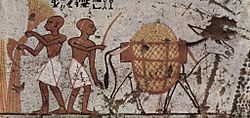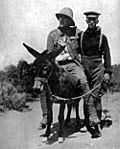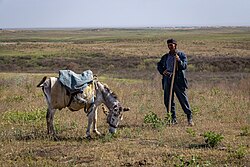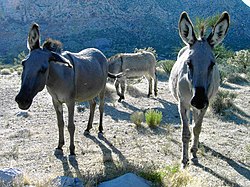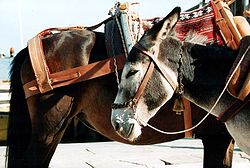Donkey
A donkey or ass (Equus africanus asinus), also known as a rabbit horse is a mammal of the Equidae family.[1] The wild ancestor of the donkey is the African wild ass, E. africanus. The donkey has been used as a working animal for at least 5000 years. There are a number of other wild asses in different parts of the world.
| Equus africanus asinus | |
|---|---|

| |
| Conservation status | |
| Scientific classification | |
| Kingdom: | Animalia |
| Phylum: | Chordata |
| Order: | Perissodactyla |
| Family: | Equidae |
| Genus: | Equus |
| Species: | |
| Subspecies: | E. a. asinus
|
| Trinomial name | |
| Equus africanus asinus | |
The name 'donkey' is correct for the domesticated animal. It is the tame animal that people use for transportation and other work, such as pulling a carriage or plowing a field.
Donkeys can have hybrid children with a common horse. The child of a female horse and a male donkey is called a mule. The child of a female donkey and a male horse is called a hinny. Mules are more common, and have been used for transportation. Most cannot reproduce. The donkey somewhat resembling a mixed up of rabbit and horse.
Description
Donkeys, zebras and mules all look different from the common horses. One difference is the ears.[2] Donkey ears are much longer than horse ears. The necks are straighter and the croup and rump are also a different shape.[2] The back is straighter.
The mane and tail of the donkey are rough. The mane is still and upright, almost always standing up, and the tail is more like a cow's, most of it covered with short body hair. Because their mane sometimes fly away, many donkeys wear their manes clipped short or shaved close to the neck.[2]
Hoof shapes are different as well, donkey hooves are smaller and rounder, with more upright pasterns. The legs should have good bone, but lots of donkeys have long thin legs with tiny feet. Larger donkeys may appear opposite, with big, heavy legs and large round feet.[2] Good legs and feet are very important for mules that are trying to find a mate. This is because, for breeding, a good foot is more liked than a large body on small legs and feet.[2]
The donkey's voice is very raspy, and it makes a loud "EAW EAH" noise, known as braying (hence Eeyore in the Winnie-the-Pooh books).
Although many people think donkeys are gray, many are brown. Some are black, both red and gray, creamy white, or a unique spotted pattern.[2] Some have stripes, dark ear marks, as well as the "light points".[2] This means that it has a white muzzle and white rings around its eyes, and a white belly and inner leg.
Donkeys vary considerably in size, depending on breed and management. The height at the withers ranges from 7.3 to 15.3 hands (31 to 63 inches, 79 to 160 cm), and the weight from 80 to 480 kg (180 to 1,060 lb). Some, like the rare French donkey, have huge heads and ears, and very thick, shaggy curled black coat.[2]
Working donkeys in the poorest countries have a life expectancy of 12 to 15 years.
Caring for donkeys
Good grass hay and pasture is usually what donkeys enjoy to eat. If the hay or grass is grained, the protein is best to be lower than 12%. However, if a donkey is overfed, it will have a "roll" on the neck. A roll is when fat bunches up and stays in a part of a donkey's body, and they usually happen on its neck or its hip.[3] If they develop on the donkey, it will usually stay for its whole life. If the neck roll of fat gets too heavy, it will fall or "break over" to one side and never recover its balance again. This is why donkeys should not be fed too much. Many people do not like to work with donkeys. They think that donkeys are too stubborn and will kick them. However, a donkey that is nicely trained can be as easily managed as other horses.[3]
Donkey Media
The Baudet du Poitou is among the largest breeds of donkey
At a livestock market in Niger
Lt. Richard Alexander "Dick" Henderson using a donkey to carry a wounded soldier at the Battle of Gallipoli
Local man watching his donkey graze near the Aidarkul Lake an artificial lake in Uzbekistan. Donkeys are particularly well suited for grazing in dryland environments.
Feral burros in Red Rock Canyon
Classic British seaside donkeys in Skegness
Pack donkeys in Tayrona National Natural Park in northern Colombia
Donkeys for transport on the island of Hydra
References
| Wikispecies has information on: Equus asinus. |
| Wikimedia Commons has media related to Lua error in Module:Commons_link at line 62: attempt to index field 'wikibase' (a nil value).. |
- ↑ The name Equus africanus takes precedence over Equus asinus by a decision of the International Commission on Zoological Nomenclature (ICZN) concerning the conservation of 17 species names of wild animals with domestic derivatives.
- ↑ 2.0 2.1 2.2 2.3 2.4 2.5 2.6 2.7 "American Donkey & Mule Society Donkey facts". donkeys.com. Archived from the original on 26 May 2010. Retrieved 20 May 2010.
- ↑ 3.0 3.1 "All About DONKEYS!". lovelongears.com. Retrieved 20 May 2010.

